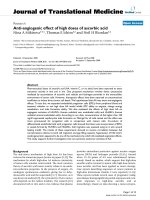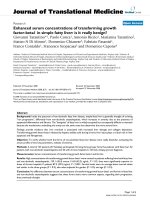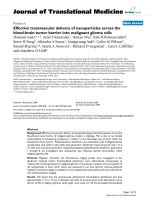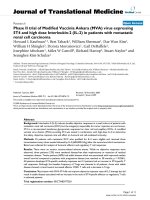Báo cáo hóa học: " Persistent deNOx Ability of CaAl2O4:(Eu, Nd)/TiO2-xNy Luminescent Photocatalyst" pptx
Bạn đang xem bản rút gọn của tài liệu. Xem và tải ngay bản đầy đủ của tài liệu tại đây (304.41 KB, 4 trang )
NANO EXPRESS Open Access
Persistent deNOx Ability of CaAl
2
O
4
:(Eu, Nd)/TiO
2-x
N
y
Luminescent Photocatalyst
Huihui Li, Shu Yin
*
, Tsugio Sato
Abstract
CaAl
2
O
4
:(Eu, Nd)/TiO
2-x
N
y
composite luminescent photocatalyst was successfully synthesized by a simple planetary
ball milling process. Improvement of photocatalytic deNOx ability of TiO
2-x
N
y
, together with the persistent photoca-
talytic activity for the decomposition of NO after turning off the light were realized, by coupling TiO
2-x
N
y
with long
afterglow phosphor, CaAl
2
O
4
:(Eu, Nd). The novel persistent photocatalytic behavior was related to the overlap
between the absorption wavelength of TiO
2-x
N
y
and the emission wavelength of the CaAl
2
O
4
:(Eu, Nd). It was found
that CaAl
2
O
4
:(Eu, Nd)/TiO
2-x
N
y
composites provided the luminescence to persist photocatalytic reaction for more
than 3 h after turning off the light.
Introduction
Hot photocatalytic research attention has been focused
on titania (TiO
2
), because of its chemical stability [1],
excellent photocatalytic activity [2] and low cost. How-
ever, since titania has large band gap energy of about
3.2 eV corresponding to the wavelength of 387.5 nm, it is
active under irradiation of only UV light less than
400 nm of wavelength. Since the content of UV light in
sun light is less than 5% [3], the development of high per-
formance visible light responsive photocatalyst which can
use main part of sunlight or indoor light is highly desired
[4-7]. Various modifications have been devoted to TiO
2
in extending the absorption edge into visible light and
enhancing the photocatalytic activity [8-13], and one of
them is doping TiO
2
with nitrogen because the band gap
of titania could be narrowed by doping with nitrogen ion
since the valence band of N2p band locates above O2p
band [14].
The aluminate long afterglow phosphor (CaAl
2
O
4
:
(Eu, Nd)) has characteristics of high l uminescent bright-
ness around 440 nm of wavelength, long afterglow time,
good chemical stability and low toxicity [15,16]. There-
fore, the coupling of TiO
2
with CaAl
2
O
4
:(Eu, Nd) was
expected to prolong the photocatalytic activity even
after turning off the light by using the persistent emit-
ting luminescence of the long afterglow phosphor as a
light source of TiO
2
photocatalyst. However, TiO
2
possessing a large bandgap energy ca. 3.2 eV can not be
effectively excited by the visible light luminescence of
440 nm from CaAl
2
O
4
:(Eu, Nd). Recently, the combina-
tions of TiO
2
photocatalyst with other long afterglow
mater ials such as BaAl
2
O
4
:(Eu, Dy) [17] and Sr
4
Al
14
O
25
:
(Nd, Eu) [ 18] were also reported. However, the emission
wavelengths of these phosphors around 495 nm [19]
and 488 nm, respectively, are also too long to excite
TiO
2
photocatalyst . Actually, it wa s reported that
BaAl
2
O
4
:(Eu, Dy)/TiO
2
and Sr
4
Al
14
O
25
:(Nd, Eu)/TiO
2
coupled compounds showed photoc atalytic performance
for the oxidation of gaseous benzene and RhB solution,
respectively, under UV light irradiation, but no notice-
able degradation was observed after turning off the
light [17].
Inthepresentresearch,wefirstlyprovidedadirect
evidence for such persistent photocatalytic deNOx sys-
tem, by the coupling of long afterglow phosphor
CaAl
2
O
4
:(Eu, Nd) with brookite type nitrogen-doped
titania (TiO
2-x
N
y
), whic h was produced by a hydrother-
mal reaction [20,21]. Brookite phase nitrogen-doped
titania possessed band gap of ca. 2.34 eV and showed
excellent photocatalytic deNOx ability even under visible
light irradiation of wavelength >510 nm [20]. In com-
parison with anatase and ru tile phase nitrogen-doped
titania, brookite phase nitrogen-doped titania photocata-
lyst has seldom been reported, however, it is expected
to be a potential novel photocatalyst.
* Correspondence:
Institute of Multidisciplinary Research for Advanced Materials, Tohuko
University, 2-1-1 Katahira, Sendai, Aoba-ku Japan.
Li et al. Nanoscale Res Lett 2011, 6:5
/>© 2010 Li et al. This is an Open Acces s article distributed under the terms of the Creative Commons Attribution License
( .0), which permits unrestricted use, distribut ion, and reproduction in any medium,
provided the original work is properly cited.
Experimental Section
CaAl
2
O
4
:(Eu, Nd) powders with the particle size of
13.9 μm(D
50
) were purchased from Nemoto Co. L td.
Other chemicals were purc hased from Kanto Chem. Co.
Inc. Japan and were used as received without further
purification. TiO
2-x
N
y
nanoparticles with brookite phase
were synthesized by hydrothermal reaction using TiCl
3
as titanium source and HMT (hexamethylenetetramine)
as nitrogen source at pH 7 and 190°C for 2 h [20].
Brookite phase TiO
2-x
N
y
nanopart icles were mixed with
desired amounts of CaAl
2
O
4
:(Eu, Nd) powders followed
by planetary ball milling at 200 rpm for 20 min. The
mass ratio o f CaAl
2
O
4
:(Eu, Nd):TiO
2-x
N
y
or P25 TiO
2
was kept at 3/2. For comparison, undoped titania
(Degussa P25) was also coupled with CaAl
2
O
4
:(Eu, Nd)
by the completely s ame manner. The UV– vis diffuse
reflectance spectra were obtained using a UV–vis spec-
trophotometer (Shimadazu, UV-2450). T he time depen-
dence of photoluminescence spectra and intensity were
measured by a spectrofluorophotometer (Shimadzu
RF-5300P).
The photocatalytic activity for nitrogen monoxide
destruction was determined by measuring the concen-
tration of NO gas at the outlet of the reactor (373 cm
3
of internal volume) d uring the photo-irradiation of a
constantly flowing 1 ppm NO/50 vol% air mixed (bal-
ance N
2
) gas (200 cm
3
min
-1
). 0.16 g of CaAl
2
O
4
:(Eu,
Nd)/TiO
2-x
N
y
,TiO
2-x
N
y
or CaAl
2
O
4
:(Eu, N d)/P25
photocatalyst m aterial was placed in the same area of a
hollow of 40 × 30 × 0.5 mm on a glass holder plate and
set in the bottom center of the reactor. A 450 W high-
pressure mercury lamp was used as the light source,
where the inner cell had water flowing through a Pyrex
jacket between the mercury lamp and the reactor. The
light of l < 290 nm wavelength was cut off by Pyrex
glass [20-22]. Before light irradiation, the NO gas was
continuously flowed through the reactor for 10 min to
achieve adsorption balance. Then, the light was irra-
diated for 30 min to realize the steady status of the
photocatalytic NO degradation and let long afterglow
phosphor CaAl
2
O
4
:(Eu, Nd) absorb enough exciting
energy. After that, the light was switched off, while the
NO gas was flowed further for 3 h.
Results and Discussion
Figure 1 shows the diffuse reflectance s pectra of
undoped and nitrogen-doped titania and the emission
spectrum of CaAl
2
O
4
:(Eu, Nd). CaAl
2
O
4
:(Eu, Nd) emit-
ted blue luminescent light with a peak of 440 nm in
wavelength by UV light irradiation (325 nm). Although
undoped titania absorbed only UV light of the wave-
length less than 400 nm, nitrogen–doped titania showed
absorption of visible light up to 700 nm showing a nice
overlap between the diffuse reflectance spectrum of
TiO
2-x
N
y
and the emission spectrum of CaAl
2
O
4
:(Eu, Nd).
Therefore, it implied the potential possibility of CaAl
2
O
4
:
(Eu, Nd)/TiO
2-x
N
y
composit e as the luminescent assisted
photocatalyst w hich use the long after glow from the
phosphor as the light source of the photocatalyst. Our pre-
vious research proved that nitrogen doped titania could be
induced the photocatalytic activity by such weak LED light
as 2.0 mW/cm
2
with long wavelength of 627 nm [23,24].
This result also strongly implied the potential application
of the composite as luminesce nt assisted photocatalyst
material.
Figure 2 shows the emissio n decay profile of C aAl
2
O
4
:
(Eu, Nd)/TiO
2-x
N
y
composite. The composite showed an
emission spectrum peaked at 440 nm, which was almost
identical to that of CaAl
2
O
4
:(Eu, Nd), attributed to the
typical 4f
6
5d
1
-4f
7
transition of Eu
2+
[16]. This indicated
Figure 1 Overlap of diffuse reflecta nce spectra of a undoped
TiO
2
(P25) and b TiO
2-x
N
y
and c emission spectrum of CaAl
2
O
4
:
(Eu, Nd).
Figure 2 The emission decay profile of CaAl
2
O
4
:(Eu, Nd)/TiO
2-x
N
y
composite after irradiation by the mercury lamp used for
photocatalytic reactions. The inset shows the decline of the
intensity of the emission.
Li et al. Nanoscale Res Lett 2011, 6:5
/>Page 2 of 4
that the even if 40% brookite TiO
2-x
N
y
was co ated on the
surface of CaAl
2
O
4
:(Eu, Nd) particles, comparatively
strong luminescence property of the composit e was kept.
Although the emission intensity decayed with time, the
emission intensity about 23 mcd/mm
2
was retained even
after 2 h.
Figure 3 shows the photocatalytic NO destruction
behaviors of CaAl
2
O
4
:(Eu, Nd)/TiO
2-x
N
y
,TiO
2-x
N
y
and
CaAl
2
O
4
:(Eu, Nd)/undoped TiO
2
(P25) under UV light
irradiation and after turning off the light. It was obvious
that all the samples possessed excellent photocatalytic
deNOx activity under UV light irradiation. Although the
effect was very limited, it could be actually confirmed
from the data of F igure 3a, b that under irradiation of
hig h pressure mercury lamp (The data between light on
and light off), CaAl
2
O
4
:(Eu, Nd)/TiO
2-x
N
y
luminescent
photocatalyst exhibit better photocatalytic activity than
that of TiO
2-x
N
y.
The characterization system used in the present research
was similar to that of the Japanese Industrial Standard
which was established a t the beginning o f 2004 [25]. I n
this JIS standard, it is recommended that the photocataly-
tic activity of photocatalyst should be characterize d by
measuring the decrease in the concentration of NO at the
outlet of a continuous reactor. One ppm of NO gas with a
flow rate of 3.0 dm
3
/min is introduced to a reactor then
irradiated by a lamp with light wavelength of 300–400 nm.
The mechanism of photocatalytic deNOx had been
researched carefully by M.Anpo [26 ]. During the deN Ox
photocatalytic reaction, the nitrogen monoxide reacts with
these reactive oxygen radicals, molecular oxygen, and very
small amount of water in air to produce HNO
2
or HNO
3
.
It was confirmed that about 20% of nitrogen monoxide
was decomposed to nitrogen and oxygen directly [26]
Because a cont inuous reaction system was utilized in the
deNOx characterization [20,21], after turning off the light,
it took about 10 min (total 50 min from the start o f the
characterizat ion ) to achieve diffusion balance and return
to the initial NO concentration.
ThedegreeofNOdestructionbyTiO
2-x
N
y
and
CaAl
2
O
4
:(Eu, Nd)/undoped TiO
2
(P25) immediately
decreased after turning off the light, however, as-expected,
CaAl
2
O
4
:(Eu, Nd)/TiO
2-x
N
y
retained the NO destruction
ability for about 3 h. Since the decay profile of the NO
destruction degree of CaAl
2
O
4
:(Eu, Nd)/TiO
2-x
N
y
was
similar to the emission decay profile shown in Figure 2, it
might be concluded that the emission by CaAl
2
O
4
:
(Eu, Nd) was used as a li ght sour ce to excite TiO
2-x
N
y
photocatalyst. It was also confirmed that CaAl
2
O
4
:(Eu,
Nd)/TiO
2-x
N
y
composite consisted of 40% brookite
TiO
2-x
N
y
(mass ratio of CaAl
2
O
4
:(Eu, Nd)/TiO
2-x
N
y
= 3/2)
possessed the best performance after turning off the light.
Present results indicate that the combination of CaAl
2
O
4
:
(Eu, Nd) and TiO
2-x
N
y
is a key point to realize the persis-
tent catalytic activity even after turning off the light. In
addition, it is well known that the combination of the two
different band structure compounds may cause the charge
transfer on the photocatalyst surface to depress the recom-
bination of photo-induced electrons and holes, which is
helpful for the improvement of photocatalytic activity
[27,28]. This novel system provides a possibility of atmo-
sphere purification not only in day time, but also in night
time. A promising strategy involves coupling of visible light
induced photocatalyst with long afterglow phosphor might
be established. It is a new concept for the photocatalyst
synthesis and applications.
Conclusion
A novel CaAl
2
O
4
:(Eu, Nd)/TiO
2-x
N
y
composit e lumines-
cent photocatalyst was successfully synthesized. Not
Figure 3 The photocatalytic deNOx activity of t he prepared samples during UV light irradiation for 30 min followed by turning off
light, while NO gas was continuously flowed in the dark for 3 h. a CaAl
2
O
4
:(Eu, Nd)/TiO
2-x
N
y
composite; b brookite phase TiO
2-x
N
y
; c
CaAl
2
O
4
:(Eu, Nd)/undoped TiO
2
(P25) composite.
Li et al. Nanoscale Res Lett 2011, 6:5
/>Page 3 of 4
only the UV-light induced photocatalytic activity, but
also the persistent catalytic ability after turning off the
light was realized successfully. The CaAl
2
O
4
:(Eu, Nd)/
TiO
2-x
N
y
composite photocatalyst provided enough
luminescence intensity for the photocatalytic reaction
for more than 3 h after turning off the light source.
Acknowledgements
This research was carried out as one of the projects under the Special
Education and Research Expenses on “Post-Silicon Materials and Devices
Research Alliance”, supported by Grant-in-Aid for Science Research (No.
20360293 & No. 22651022).
Received: 3 July 2010 Accepted: 6 August 2010
Published: 20 August 2010
References
1. Li Y, Sun X, Li H, Wang S, Wei Y: Powder Technol 2009, 194:149-152.
2. Kim D, Kwak S: Appl Catal A-Gen 2007, 323:110-118.
3. Tafen D, Wang J, Wu N, Lewis J: Appl Phys Lett 2009, 94:093101.
4. Yin S, Zhang Q, Saito F, Sato T: Chem Lett 2003, 32:358-359.
5. Yin S, Yamaki H, Komatsu M, Zhang Q, Wang J, Tang Q, Saito F, Sato T:
J Mater Chem 2003, 13:2996-3001.
6. Wang J, Yin S, Zhang Q, Saito F, Sato T: J Mater Chem 2003, 13:2348-2352.
7. Aita Y, Komatsu M, Yin S, Sato T: J Solid State Chem 2004, 177:3235-3238.
8. Moon J, Yun C, Chung K, Kang M, Yi J: Catal Today 2003, 87:77-86.
9. Cho Y, Kyung H, Choi W: Appl Catal B:Environ 2004, 52:23-32.
10. Kaur S, Singh V: Ultrason Sonochem 2007, 14:531-537.
11. Liu S, Chen X: J Hazard Mater 2008, 152:48-55.
12. Chen F, Zou W, Qu W, Zhang J: Catal Commun 2009, 10:1510-1513.
13. Jirapat A, Puangrat K, Supapan S: J Hazard Mater 2009, 168:253-261.
14. Asahi R, Morikawa T, Ohwaki T, Aoki K, Tage Y: Science 2001, 293:269-271.
15. Chang C, Xu J, Jiang L, Mao D, Ying W: Mater Chem Phys 2006, 98:509-513.
16. Zhao C, Chen D: Mater Lett 2007, 61:3673-3675.
17. Li S, Wang W, Chen Y, Zhang L, Guo J, Gong M: Catal Commun 2009,
10:1048-1051.
18. Zhang J, Pan F, Hao W, Ge Q, Wang T: Appl Phys Lett 2004, 85:5778-5780.
19. Chen X, Ma C, Li X, Shi C, Li X, Lu D: J Phys Chem C 2009, 113:2685-2689.
20. Yin S, Aita Y, Komatsu M, Wang J, Tang Q, Sato T: J Mater Chem 2005,
15:674-682.
21. Yin S, Hasegawa H, Maeda D, Ishitsuka M, Sato T:
J Photoch Photobio A:
Chem 2004, 163:1-8.
22. Gateshki M, Yin S, Ren Y, Petkov V: Chem Mater 2007, 19:2512-2518.
23. Yin S, Zhang P, Liu B, Liu X, Sato T, Xue D, Lee S: Res Chem Intermed 2010,
36:69-75.
24. Yin S, Liu B, Zhang P, Morikawa T, Yamanaka K, Sato T: J Phys Chem C 2008,
112:12425-12431.
25. Japanese Industrial Standard (JIS R 1701-1:2004(J)), Test method for air
purification performance of photocatalytic materials—part 1: removal of
nitric oxide, Japanese Standards Association, Established on 20-Jan-2004.
26. Anpo M: “Recent Development on Visible Light Response Type
Photocatalyst”. NTS, Tokyo; 2002, 9, (ISBN4-86043-009-03).
27. Wang J, Xie Y, Zhang Z, Li J, Chen X, Zhang L, Xu R, Zhang X: Sol Energ
Mat Sol C 2009, 93:355-361.
28. Kamei M, Miyagi T, Ishigaki T: Chem Phys Lett 2005, 407:209-212.
doi:10.1007/s11671-010-9750-7
Cite this article as: Li et al.: Persistent deNOx Ability of CaAl
2
O
4
:(Eu, Nd)/
TiO
2-x
N
y
Luminescent Photocatalyst. Nanoscale Res Lett 2011 6:5.
Submit your manuscript to a
journal and benefi t from:
7 Convenient online submission
7 Rigorous peer review
7 Immediate publication on acceptance
7 Open access: articles freely available online
7 High visibility within the fi eld
7 Retaining the copyright to your article
Submit your next manuscript at 7 springeropen.com
Li et al. Nanoscale Res Lett 2011, 6:5
/>Page 4 of 4









